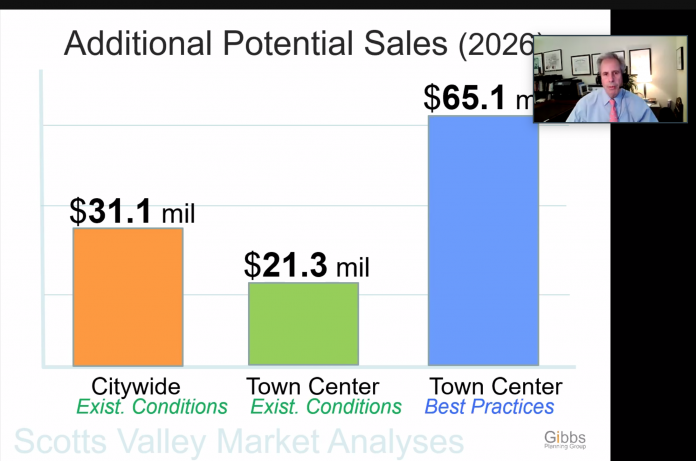SCOTTS VALLEY—Scotts Valley elected officials listened with rapt attention as influential urban planner Bob Gibbs gave them “a really short version of my Harvard class,” during a study session before the June 2 City Council meeting. As he pulled the cover back on what the city could hope to manifest on the Town Center land, there was positive news, but some challenging revelations, too.
“This is not going to be a retail Town Center,” Gibbs said, pointing to banks’ skittish attitude toward commercial projects in the online era. “This is going to be a mixed-use center that has some retail.”
Gibbs Planning Group scored a year-long contract to evaluate the land civic leaders want to manifest into something to serve locals, attract visitors and inject more life into the community.
According to the initial study, Scotts Valley can accommodate 40-50 new retailers and restaurants in about 80,000 square feet of additional retail and restaurant space. If the city hits it out of the park, business-wise, it could squeeze up to 100 new shops and watering holes into 170,000 square feet of space, the local officials heard.
“We know the Town Center has been a work in progress for many-a-year,” said City Manager Tina Friend, during the introduction. “We hired the Gibbs Planning Group to provide guideposts on this journey.”
Friend said she’s been learning from the consultant that while some such retail projects are succeeding, most aren’t. In the best-case scenario, development could lead to a total sales increase of $65.1 million by 2026, according to the analysis.
“I think your timing is really good right now because we’re coming out of the Covid crisis,” Gibbs said, adding that it’s been hard to see so many commercial developments—including ones he’s worked on—fail in recent days. “This last phase has been very humbling.”
Chief among the results was how Scotts Valley, Gibbs said, stands head and shoulders above the competition in the eyes of institutional investors.
For one, the community’s residents tend to be wealthier, with a median income almost twice as much as the retail baseline, he said, adding that the community can technically boast a high “walkability” score, despite the suburban environment.
Plus, around 80% of the people residing in Scotts Valley’s orbit are from “lifestyle groups” marketers crave access to.
“More than half of your market is Urban Chic,” he said, adding the area is home to many so-called Savvy Suburbanites and older folks who have weathered financial crises well. “The data we purchase is quite invasive.”
However, Gibbs went on, financiers aren’t looking to invest in retail projects unless they include at least 300 units of housing as part of a deal similar to the size Scotts Valley is pursuing.
“Retail is highly risky,” he said. “It’s always changing.”
Even then, many underwriters want to see at least one top-notch office thrown in to drive retail traffic during the day, and a hotel with at least 150 rooms, Gibbs said. They also want to see a grocery store, to attract customers, he said, adding, while the proximity of Nob Hill Foods and a new Target could satiate this desire, a “specialty green grocer” might fit the bill.
Vice-Mayor Jim Reed said this was all “better than I was expecting,” but he wondered how much Gibbs’ projections would change if the City Council only approved around 250 residential units.
“I don’t think it would be dramatically different,” Gibbs said, declining to be more specific, as with when Reed asked how affordable housing requirements could impact the model. “We assumed an average of two people per home. They don’t have to all be very high income.”










